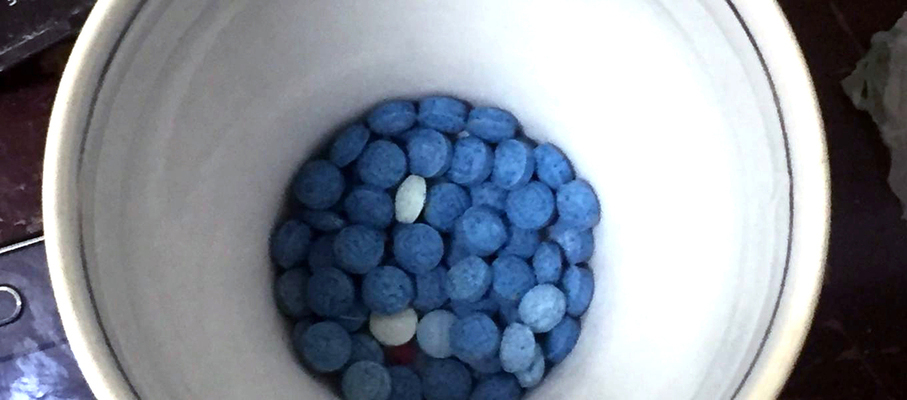Breathtakingly Dangerous: Fentanyl Is Everywhere, And Is Claiming Lives
The arrest of an alleged fentanyl trafficker in a house in West Chatham last week and the apparent overdose death of a woman in the same house has put the drug in the spotlight. But as local first responders will attest, fentanyl is already everywhere, and it’s deadly.
“Fentanyl is a synthetic opioid, and in 2022 was responsible for over 100,000 deaths in the U.S.,” said Dr. William Shay of Outer Cape Health Services, who is a board certified expert in addiction treatment. “Personally I have seen three deaths in the past six months. It is a heartbreaking tragedy for them, for their families, and for those that care for them,” he said.
Fentanyl Is Prevalent
The drug is nothing new to Cape Cod, first appearing here sometime around 2012. Used clinically, it’s an important treatment for the severe pain caused by cancer and similar diseases because it is around 100 times more potent than morphine and 50 times stronger than heroin. Illegally manufactured fentanyl (IMF) is now extremely prevalent and poses an obvious risk, according to Dr. Michael Hall, chief of emergency medicine at Cape Cod Hospital.
“It stands to reason that with 50 to 100 times the potency of naturally occurring opiates, IMF overdoses and deaths are on the rise,” he said. The CDC reported that, in 2021, there were nearly eight times more deaths from IMF than from heroin. That year, an average of 193 people a day died from fentanyl overdoses, compared to five from heroin. “Shockingly, 88 percent of all opiate overdose deaths were directly related to IMF,” Hall said. “Opiate overdoses occur almost daily and almost all the opiate overdoses that present to the [Cape Cod Hospital] Emergency Center are suspected to involve IMF use,” he said.
“It has overtaken heroin in the community, and in fact you can no longer find heroin on the street, so I am told,” Shay said.
At about the time fentanyl began hitting the streets, public health officials launched a number of initiatives to try and reduce the surge of overdose deaths.
“When overdoses were spiking, people were getting left on the side of the road,” Deputy Chatham Police Chief Lou Malzone said. In response, the state revised its Good Samaritan Law, which protects overdose victims and those who call 911 from being charged with possession or use of controlled substances. There was a new push to install lockboxes to receive people’s unused prescription drugs to keep them from being used illegally. And there were efforts to improve the availability of naloxone, the overdose-reversing drug commonly known as Narcan. These initiatives were important, but have failed to stem the tide of fentanyl deaths.
How It Kills
In uncontrolled doses, fentanyl is literally breathtaking. It causes respiratory distress that can stop the heart in a way that is more difficult to reverse than a traditional heart attack or irregular heartbeat, Hall said.
“In addition to the risk of respiratory depression associated with IMF, it is common for IMF to be combined with other drugs,” he said. When paired with heroin or barbiturates, fentanyl amplifies the sedative effect; with cocaine, it raises the risk of heart attack, stroke and seizure. And when coupled with methamphetamines, it can cause unpredictable behavior that leads to accidental death or suicide.
“Lately it has been mixed with xylazine, a horse tranquilizer called ‘tranq’ on the street, and the mixture is called ‘tranqdope,’” Shay said. “It increases the danger because an OD with fentanyl and xylazine looks the same as fentanyl but is not reversed with Narcan, which is the first line of treatment for a suspected OD,” he said.
People who are users of other drugs can use the same amount of fentanyl and immediately overdose, Malzone said. People using other drugs might have minutes to hours before they overdose, and with fentanyl, “it’s seconds to minutes,” he said. For most users, there isn’t time to self-administer Narcan.
“IMF is commonly made to look like commonly prescribed pills, or even nasal sprays and eye drops. Rest assured, these would not be the medications you pick up at the local pharmacy,” Hall said.
A person might be experiencing back pain, and a friend offers a pill that looks like a legitimate prescription drug. Though you might not be a habitual user, you might take a single pill, “you overdose and then you’re dead,” Malzone said.
How It Ruins Lives
For people who are addicted, fentanyl sells for between $80 and $100 per gram locally, police say, and users might eventually find they need more than one gram per day. In addition to destroying their family and work relationships, fentanyl can quickly force people who would otherwise never commit a crime to steal in order to sustain their addiction, Malzone said. And while those activities are crimes, “being an addict is not illegal,” he said. Police on the Lower Cape are committed to helping people who are in recovery, Malzone stressed.
Whether the substance is fentanyl, a different drug or alcohol, substance abuse disorder has predictable effects on people and their loved ones, said Daniel Rodrigues, director of substance use disorder and outreach programs at Duffy Health Center.
“The impacts across the board don’t change. We see the same kind of story,” he said. People who are addicted suffer obvious health problems that soon morph into lifestyle problems involving work and relationships. “Once your body is physically dependent on a drug or alcohol, and once your mind has become rewired and is now psychologically addicted to a substance, how do you maintain a quote-unquote normal life” when your key bodily functions have been hijacked, Rodrigues said. Stretched and broken family relationships result, work becomes difficult or impossible, brushes with the law can result, and ultimately a person can die, he said.
A complicating factor is the fact that society continues to treat substance use as a moral failure rather than a medical one, Rodrigues said. People with substance use disorder don’t often share their experience with others “because they’re going to be seen as less of a person,” he said.
“I think there’s a stigma, a kind of stereotype here of what a drug user is,” Malzone said. There is no stereotypical fentanyl user. “It doesn’t discriminate by town or by social class. It doesn’t discriminate at all,” he said. Sometimes after an overdose, police will talk to the victim’s family members, who say they had no idea there was a problem. “Well, they probably didn’t,” Malzone said.
“The stigma oftentimes stops the family and the user from seeking help,” he added. Despite old-fashioned belief, “once an addict, always an addict,” some people are able to free themselves from addiction.
“There are people who can get out of it,” Malzone said. “I have seen success stories. The sad thing is when people don’t have an opportunity because they overdose and die.”
Public Health Initiatives
Public health officials around the Cape and around the nation are using a multifaceted approach to the fentanyl crisis. Harm reduction programs by groups like the AIDS Support Group of Cape Cod provide clean needles and special test strips that help users find out whether their drugs are laced with fentanyl. Methadone and suboxone treatment are available at locations around Cape Cod to help people in recovery. Outer Cape Health Services operates a Structured Outpatient Addiction Program, or SOAP, an intensive virtual or in-person program run by behavioral health experts three times each week.
Communities have also started to implement programs using funding from the opioid class action settlement program. Chatham Health Agent Judith Giorgio said the town has received around $87,000 so far, and “we are slated to receive $354,000 over the course of the payout in July 2038.” Some of the funds have been awarded to the Fishing Partnership for a Narcan and needle risk harm reduction program, and $5,000 was awarded to Behavioral Health Innovators for preventative programs at Monomoy Middle School.
Progress has clearly been made from a public health and harm reduction perspective, Rodrigues said, but the reality is sobering.
“Our overdose data as a county and as a state and as a nation continues to escalate,” he said.
Help For Individuals
Malzone said officers will often offer help to people struggling with substance use disorder, but then find themselves worrying whether a treatment bed is available in an inpatient program locally. And when a user asks for help, there is often a very short window of opportunity to intervene, he said. Even if a bed is available, would-be patients might be unable to commit to an inpatient treatment program fearing they will lose their job, or because they are responsible for caring for an aging parent.
To that end, Outer Cape Health Services and Duffy Health Center are providing communities with recovery coaches who spend time in each community, offering one-on-one counseling. The coaches are often people who are also in recovery, and understand the obstacles that can prevent treatment, Malzone said. In Chatham, Recovery Coach Kelly Connolly holds hours at the police station every Wednesday from noon to 4 p.m.
“She can help them navigate the recovery world and get into a program that will work for them,” he said. So far, the coaching has been effective, he said.
“If we help one person to navigate the recovery services, it’s a success,” Malzone said.
A Social Justice Issue
There’s another dark truth about the opioid crisis: it was a public health emergency among urban, nonwhite communities for many years before it started making headlines.
“Where our community started to really pay attention...was when drugs like heroin started to infiltrate into our more affluent and white community,” Rodrigues said. To make real progress in the fight against fentanyl, Cape Codders need to focus on providing equitable access to health care for everyone, he said.
In the long run, curbing the crisis begins with education and prevention efforts, “starting young and continuing to destigmatize substance use,” Rodrigues said. “That’s a starting point.” Next, the community needs to prioritize the creation of inpatient treatment beds and appropriate outpatient programs, he said. On Cape Cod, two glaring social problems only amplify the fentanyl crisis, and they have to be addressed for any long-term progress to happen.
“One is the lack of transportation,” he said. “If you can’t get to and from treatments or to your support network, how can you be successful?”
The second problem is housing. While the housing shortage affects many people locally, there is an acute need for housing for people who are in different phases of the recovery process, Rodrigues said. Unfortunately, some people who receive proper treatment for substance use disorder relapse because they have trouble finding a safe place to live.
“We still know that our most marginalized community members continue to be disenfranchised,” he said. Whether they are nonwhite people, LGBTQ-plus people or non-English speaking people, “all of these communities still aren’t getting the same level of care that our non-marginalized communities are,” he said.
If you are experiencing a substance use problem, get help by calling 988.
Please support The Cape Cod Chronicle by subscribing today!
You may also like:








